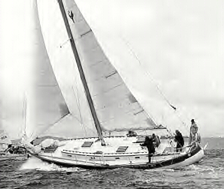by Sylvia Williams Dabney. Source – Good Old Boat October-1998
We learned to sail on Puget Sound. Like so many other people who live and cruise the Pacific Northwest, we were happy to be on our summer cruise in August … it is the best of the best of cruising times. The weather is generally clear with little, if any, fog. Winds are light. The sun is out nearly every day, and the air is so clear it turns the sky the most amazing color of blue you’ll see anywhere. In the background are craggy snow-capped mountains. It is a place of the ultimate primal alliance … a nearly perfect cruising ground … a place where islands and bays stretch for endless miles. The last week of August is our favorite, and we always laugh when we say, “Wednesday during the last week of August is always Perfect.” It was always a good rule of thumb.
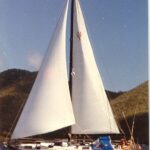
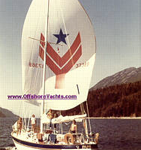
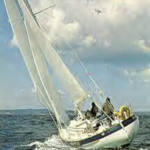
A Taste Of Reality
It must have been a Thursday or Friday of that last week in August, 1972, when we were crossing the Straits of Juan de Fuca, sailing toward Victoria B.C. where we hoped to dock infront of the Empress Hotel in time for afternoon tea. All sailors who have been to the Empress for tea, tell all of the other sailors heading toward the Canadian Gulf Islands, that this is a tradition you must not miss. We were looking forward to participating in this tradition and discussed what the proper attire would be, as we thundered along under full spinnaker in our Islander 36′, “Amalia”. The wind was building and it was time to reef.
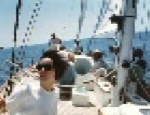
Where It Started
(Nathan Rothman and Stanley Dabney “the first sail”)
And Then Came Valiant.
Westsail was just coming into being and was even featured on a cover of Time Magazine and after we called the California office, a factory rep came to our house in Seattle to show our father, Nathan and us the lines and to tell us about all the plans they had for this new boat. It was nice, but like shoes, it simply just didn’t fit us.
Around this same time, a mutual friend who knew of our sailing passions, introduced us to Jay Benford, a local yacht designer and Ferrocement guru, who was designing Ferrocement boats in Seattle. After the Corporate escape, we had established a printing and publication company and became the printers of Jay Benfords design books. It was just wonderful to see the designs, reviews and new drawings he brought to us for printing and we were enthralled with the “new” concept of Ferrocement. Remember, this was the era of the great escape and we became one of the group who actually considered a “concreter”…it made sense to us at the time and afterall, there were not too many alternatives at that time. During the Seattle Boat Show, sometime around 1972, Jay Benford invited us to come to the show and see a “real live” Ferro cement boat being built. As it turned out, this was the first time we met Nathan Rothman who had recently arrived from New York, where he was selling buttons on the street with John Lennons photo on them and working at various City Island boat yards. Nathan was now working for Jay Benford, building production Ferrocement yachts. Next to Nathan, inside this huge chicken wire cage, smearing concrete, was Bob Perry, who was working for Jay Benford as an assistant designer.
Nathan, his significant other Linda, Bob and we, instantly became great friends, after the show that night, over great big bowls of Spaghetti at the recently opened Spaghetti House in Seattle…gourmet dining for us in those days. It was just one of those special relationships where we did a lot of dreaming, laughing, talking and we spent endless hours together. Nathans girlfriend Linda was unemployed, so I got her a job with my brother in a plant shop in the University district of Seattle and Bob who was then batching it, soon moved aboard our Islander 36′ at Shilshole Bay Marina. We all spent a lot of time onboard our Islander 36′ and in the cafes around the Seattle marinas, drawing on napkins, what would be our dream boat…a good livable blue water yacht. We talked about berths, galleys, storage and performance. After a 3 month cruise to Alaska aboard a ketch rigged Sea Spirit 32′, essentially a smaller version of a Sea Wolf 41′, we really started defining what our concept of what a live aboard cruising yacht was, what performance was, what comfort aboard meant (primary issue were a few less leaks) and what for us, would be the ideal layout above and below decks. Of course, every time we found what we thought was a suitable boat, Nathan would tell us it was not right for us. Up to that point, most offshore cruising boats were heavy and slow and not all that fun to sail.
The “U” shaped galley was a must on our list, the proper forward facing and really usable nav station which would hold a large compliment of navigation equipment, was also at the top, as was a real double berth on which fitted sheets could be used. We wanted a traditional layout and Bobs concept of performance was critical, as it fit our desires like a glove. All of these ideas eventually evolved into the VALIANT 40.
With the collapse of the “concrete era”, both Nathan and Bob soon found themselves unemployed. Nathan suggested the we have Bob Perry work all of our ideas into a design, as we all had the same thoughts and dreams. Our parameter for performance was that it had to sail equally as well as our Islander 36′. Hull shapes were tossed around, other Seattle friends, Mary and Bill Black, Steve Murphy and Darryl McNabb started hanging over our shoulders looking at the ensuing plans and we began hearing “yes, we would also be really interested in this boat”. So it was that all four of us were interested in the same type of cruising yacht!!! Bob was young, hugely creative in his yacht designs and a great friend. We had talked about what had disappointed us in other boats, threw ideas around and spent so very many hours aboard our Islander 36 and a few local cafes, drawing, erasing, talking, laughing and never thinking Valiant Yachts would be born!
Having been influenced by Scandinavian fishing boats and other double enders which we were used to seeing in the Pacific North West, some of which were off the board of another great local yacht designer, William Garden, we were greatly impressed with the cover of a Soundings magazine that Nathan brought to the cafe one morning. Nathan asked if we would be interested in a boat that looked like this. It was beautiful !!! “Holga Dansk” was the name of the boat and she had the most beautiful hull design we had ever seen. We were struck with lightening it seemed, we had the inside lines we wanted and now there she was, a hull design and styling we just had to have…now we had a decision to make…that was easy, but how and where do a bunch of kids build a boat. (Later at the Miami Boat Show in 1975 I think, where Nathan, Stanley and I were introducing VALIANT to the world, we had some “big time boating big whig” come to our booth, where we had drawings and a projector with slides of what we were doing in the boatbuilding industry! His comment, which we have never forgotten was that we were the “cutest kids I’ve ever seen, the boat looks pretty nice, but you will never make it…you can’t just start a company like that!!!). Back then, we didn’t know better. Nathan was unemployed at the time, Linda, Nathans girlfriend was working at my brothers flower shop for low pay, Jay Benfords Ferrocement production company was out of business, and Bob Perry was unemployed as well. We all were pretty motivated to take some action.
